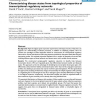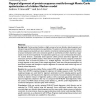820 search results - page 43 / 164 » Using Multiple Alignments to Improve Gene Prediction |
BMCBI
2006
13 years 9 months ago
2006
Background: High throughput gene expression experiments yield large amounts of data that can augment our understanding of disease processes, in addition to classifying samples. He...
BMCBI
2007
13 years 10 months ago
2007
Background: Microarray techniques survey gene expressions on a global scale. Extensive biomedical studies have been designed to discover subsets of genes that are associated with ...
BMCBI
2010
13 years 4 months ago
2010
Background: The correlation between the expression levels of transcription factors and their target genes can be used to infer interactions within animal regulatory networks, but ...
BMCBI
2004
13 years 9 months ago
2004
Background: Certain protein families are highly conserved across distantly related organisms and belong to large and functionally diverse superfamilies. The patterns of conservati...
ICML
2004
IEEE
14 years 10 months ago
2004
IEEE
In this paper, we present a graphical model for protein secondary structure prediction. This model extends segmental semi-Markov models (SSMM) to exploit multiple sequence alignme...


